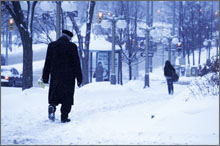Will Your Tongue Really Get Stuck to Cold Metal? (And Other Strange Winter Questions You Always Wondered About)
by www.SixWise.com
Flick was the unfortunate character of the holiday classic, A Christmas Story, who was dared to stick his tongue on a metal pole in winter. The result was catastrophic -- his tongue stuck to the metal pole.
|

If your tongue gets stuck to a metal pole (we won’t ask how it happened …), pouring warm water over it will melt the ice.
|
Would this happen in real life, or only in the movies?
Here are the answers to this and some equally quirky questions about winter-related topics …
1. Will your tongue stick to cold metal in the winter?
Yes! So don’t do it! Water freezes at a temperature of 32 degrees Fahrenheit (F) or lower. In the winter, metal objects can easily be 32 degrees F or colder, which means that if you so decide to lick a metal pole, the water from your tongue will freeze solid, fusing your tongue to the pole.
Pouring warm water over your tongue will melt the ice, but wouldn’t it be better to just resist the temptation in the first place?
2. Can two snowflakes be alike?
Yes, it is possible that two snowflakes could be alike in their smallest form, but to find actual proof by comparing all possible pairs but would take about 100,000 years.
Snowflakes start out as dust particles floating in a cloud. Water condenses on the particle and freezes, forming crystals. Snow crystals tend to be hexagonal (six-sided) because of the way the atoms are arranged in the water molecule.
When snow crystals start out, they are very small. Some of them fall before they have a chance to fully develop into a typical snowflake, which is a half an inch to two inches wide. Of these simpler ice crystals, it is possible to have two the same.
However, depending on the temperature and swirling atmospheric conditions, snowflakes can grow and combine with one another to create unique crystal formations. So by the time snowflakes reach the ground, it is extremely unlikely that any two will be the same. But the truth of the matter is that it is impossible to sift through the million billion cubic feet of snow that falls on the earth each year to find out for sure!
3. Why do your hands get numb in the cold?
Numb hands due to exposure to cold weather is a sign of mild hypothermia. Mild hypothermia can occur when body temperatures are between 98.6 and 95 degrees F. Cold temperatures, wind, and moisture all contribute to the loss of body heat.
Mild hypothermia is characterized by mild shivering, goose bumps, numbness and slight lack of muscle coordination in fingers, and slight mental impairment. If symptoms increase to violent shivering, severe muscle coordination problems, and impaired judgment, then moderate hypothermia is occurring. Severe hypothermia occurs when shivering stops and there is a complete lack of muscle coordination, muscle rigidity, and unconsciousness.
Treat mild hypothermia by coming in out of the cold, replacing any wet or damp garments with dry ones, and drinking something warm to try to warm the body core (internal organs) first. Moderate hypothermic victims should be treated with warm heat packs or wrapped hot water bottles applied to the neck, armpits, and groin only. Victims of severe hypothermia require immediate medical attention and should be taken to the nearest hospital as quickly as possible.
Most hypothermia can be prevented by dressing appropriately -- so bundle up!
4. Does salt melt snow and ice … and does it really eat the pavement?
|

A blizzard is defined as a winter storm with strong winds, low temperatures, heavy, blowing snow and low visibility that lasts for at least 3 hours.
|
Salt really dose melt snow -- and some ice. Water freezes at 32 degrees F. Introducing salt to snow lowers the freezing point of water to about 15 degrees F on roads and sidewalks. The salt, however, is unable to enter the solid molecular structure of the water below 15 degrees F. What this means is that if the temperature of the ice is lower than 15 degrees F, the salt will no longer be able to melt it.
Salt does not eat concrete pavement, but it can cause it to split. Concrete may appear dense, but is actually very porous. When salt causes snow and ice to melt, the concrete absorbs all of that water. If temperatures then drop the absorbed water will expand and freeze, sometimes causing the pavement to crack or shatter.
5. What’s the difference between a snowburst and a blizzard?
A snowburst is a short period of heavy, consistent snowfall -- usually around 10-14 hours or so with snow falling at a rate of 2 or more inches per hour. If conditions worsen, then it becomes a blizzard. A blizzard is defined as a severe winter storm characterized by strong winds (at least 35 mph), low temperatures, heavy, blowing snow, and low visibility (a quarter mile or less) that lasts at least 3 hours.
6. How and why do animals hibernate in the winter?
Animals such as some bears, squirrels, and hummingbirds hibernate in the winter. Hibernation is a process that allows certain animals to drastically reduce their heart rate and thus their body’s energy needs in harsh conditions. When temperatures are frigid and food is scarce, these animals hibernate (remain dormant/inactive) to conserve energy instead of searching for food for days and possibly starving or freezing to death.
Squirrels can wake up every 4 days or so to eat and take a potty break, whereas black bears can hibernate for up to 7 months without food, water, or relieving themselves!
Recommended Reading
How NOT to Shovel Snow and Other Important Winter Tips
What Not to Do for Cold Hands and Seven Other Winter Tips
Sources
Ask the Builder. Deicing Salts and Concrete. December 2008
Choi, Charles Q. Two Snowflakes May Actually be Alike. January 22, 2007
CoolQuiz.com. Why do Some Animals Hibernate in the Winter. December 2008
Cornell Centers for Material Research. Metal’s Thermal Conductivity Makes Your Tongue Stick in Winter. September 13, 2006
EHow.com. How to Recognize and Assess Hypothermia. December 2008
The Bear Den. December 2008
The Canadian Encyclopedia. Cold-Weather Injuries. December 2008